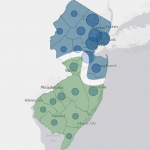New Jersey Future Blog
Regional Planning Efforts Deliver Results
October 14th, 2010 by Chris Sturm
- Since the adoption of its first Comprehensive Management Plan in 1981, the Pinelands Commission has steered development away from environmentally sensitive areas, safeguarding the region’s aquifer, blueberry and cranberry farms and other natural resources. Through 2002, the most recent year for which data are available, fewer than five homes per year had been approved in the core Preservation Area.
- Municipalities in the Pinelands region enjoy better economic health than municipalities in the non-Pinelands towns of South Jersey, as measured by unemployment rates, property taxes, property values, growth of new business establishments and “effective tax rates,” a key indicator of municipal fiscal stress.
- Since its creation in 1968, the New Jersey Meadowlands Commission has promoted a balance of orderly economic development and environmental protection and restoration in the Meadowlands District. The district has experienced more than $2 billion dollars in development over the past four decades, resulting in more than $9 billion in tax revenue for district municipalities. Over the same time period, the commission has preserved more than 4,000 acres of environmentally sensitive wetlands and helped create 21 parks with more than 10 miles of hiking trails. More than 280 species of birds now call the Meadowlands their permanent or seasonal home.
- Forty years ago, there were 51 mostly unregulated landfills in the Meadowlands. Today, there is one operating landfill. Its revenue helps fund the commission’s activities, including appropriation over the last seven years of nearly $10 million in direct aid to the region’s 14 municipalities.
Success Linked to Consolidated, Region-Wide Decision-Making
Regional land use planning has been used successfully in New Jersey to manage resources that transcend municipal boundaries. It is enabled when the Legislature transfers municipal authority to plan and regulate development to a regional planning agency. Regional planning consolidates land use decision-making in a way that not only allows for a bigger-picture perspective, but also can provide greater efficiency, accountability and technical resources than individual municipalities acting alone.
The Pinelands Commission was created by the Pinelands Protection Act in 1979 to protect the region’s natural and cultural resources, including the Kirkwood-Cohansey aquifer system and its estimated 17 trillion gallons of pure water. The Pinelands region spans 53 municipalities in seven counties and covers 22 percent of the state.
The Hackensack Meadowlands Reclamation and Development Act of 1968 charged the Meadowlands Commission with providing for environmental protection, orderly development and solid waste disposal facilities in a 30-square-mile region that encompasses portions of 14 municipalities in Bergen and Hudson counties. This is accomplished, in part, through a unique tax-sharing arrangement among the municipalities.
Both the Pinelands and Meadowlands commissions continue to actively manage growth and preservation activities in accordance with their specific statutory mandates, and are upheld as national models.
The state’s most recent regional planning legislation, the Highlands Water Protection and Planning Act of 2004, was designed to protect water resources in a region covering 88 municipalities and 17 percent of the state’s land area. The Highlands Council adopted a Regional Master Plan in 2008 —and recently approved the first municipal petition for conformance from Byram Township.
The Highlands effort has not been without controversy. For example, some landowners contend their property values have been unfairly reduced, while some environmentalists protest that land use protections should be stronger. Similar tensions have existed over the years in both the Pinelands and Meadowlands, where experience has shown that a steady commitment from the state, combined with a strong regional planning entity, can resolve them equitably. If the state remains resolved to protecting water resources in the Highlands, the regional planning powers exercised by the Highlands Council will be essential to success. With time and commitment, New Jersey’s experience in the Pinelands and Meadowlands makes it clear that regional planning delivers results.

















I think you have neglected to consider the disastrous environmental effects of placing all the development that would have been in the Pinelands into the shore communities just outside the Pinelands District. Municipalities like Egg Harbor City along Barnegat Bay now have tremendous development which is severely negatively impacting the Bay. The areas just outside the Pinelands should be considered in determining success. “Transferring” the environmental problems to another area is not success.
Jay, Well said! Many people do not appreciate the economic benefits of what is fundamentally an environmental protection program, but they are real. If not for the Pinelands Plan, all of Ocean, Burlington and Atlantic Counties would now look like the places outside the Pinelands boundary with a patchwork of disconnected, sprawling, homogeneous, polluting subdivisions.
Joan Mcgee points to two of the real problems that still exist: First, whenever you draw a boundary, you leave something out. In this case, development along the shore (not under the jurisdiction of the Pinelands Commission) was left to the CAFRA program, with disastrous results for Barnegat Bay and some other estuaries. In this case, the state has to get involved in reversing the damage. Gov. Christie has said he will have a plan to restoring Barnegat Bay – which will have to involve a new land use management paradigm for the watershed – but he has not yet announced what that plan will be.
Second, the Pinelands Commission historically left towns to decide how to develop within their growth zones, and many did a poor job with it. Some municipal leaders, like those in Egg Harbor Township, chose to blame the Pinelands for their own poor planning over the last three decades, but the Pinelands program gave them more than enough freedom to plan well if they had chosen to take up the challenge. More recently, the Commission has made some effort to work with towns on planning inside the growth zones. And some towns have taken a positive approach and done well. Hammonton and Hamilton, near neighbors of Egg Harbor Township, come to mind. There certainly was nothing in the Pinelands Plan that forced Egg Harbor Township to plan for low-density, sprawling, and fiscally draining subdivisions across its growth area.
Thanks for the feedback! I should point out though that it was actually Chris who wrote this piece. I merely posted it on the blog. I’ll pass along the praise.
Jay
Joan highlights what sprawl development can do to the environment, in this case in the Barnaget Bay. In my mind it’s a good argument for more regional planning not less. If an effective regional planning effort was in place along the shore (rather than CAFRA, with all its loopholes), we’d have a better outcomes there. But Carleton is right; you need not only general tools to dictate “where” growth goes, but also guidance on “how” it happens, so it creates great places for people to live and work, without compromising the environment.
Would south Jersey – Pinelands and coastal areas – be better off today with our without the Pinelands regional planning framework? What would it look like? I think the question is easy to answer…
Hello –
Google’s Blog Search sent me to this/your project because of the keyword “regional.” This should be useful to subscribers of Regional Community Development News, so I will include a link to it in the October 25 issue.
The newsletter will be found at http://regional-communities.blogspot.com/
Please visit, check the tools and consider a link.
New Jersey does not have a network of State Standard sub-state districts/regions, Likve Virginia and many other states. Multi-county regions need to work internally to their region, as well as edge to edge with adjoining regions, be they in the same state or not.
It is this sort of planning perspective that we are trying to encourage with the Mid-Atlantic Regional Planning Roundtables sponsored by the APA Regional and Intergovernmental Planning Division and the APA State Chapters, including New Jersey.
The last event was in Wilmington, Delaware. You can check the program at http://www.wilmapco.org/mid-atlantic/ A current goal is to estalish a learning network to share issues, understandings and practices of existing regional planning organizations.
Tom